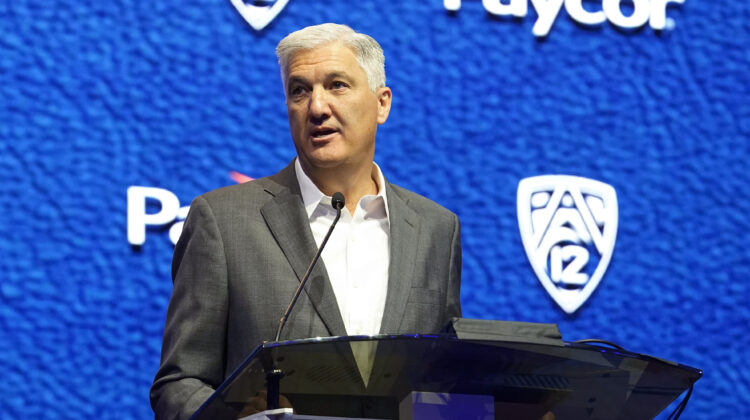The Hotline mailbag typically publishes each Friday. Given the extraordinary developments that led to the demise of the Pac-12, we are planning a series of mailbags (beginning today) in the hopes of addressing all the topics that matter to our readers.
Send questions to pac12hotline@bayareanewsgroup.com and include ‘mailbag’ in the subject line. Or hit me on Twitter: @WilnerHotline
Please note: Some questions have been edited for clarity and brevity.
How much money is in the Pac-12 accounts? And are the four remaining schools obligated to share that, and the 2023-24 revenue, with the departing schools? — @grasslandJerry
The finances are critical to the next move for the remaining schools, and there are many unknowns at this early stage. But we have been told by multiple sources that the quartet controls the conference as the lone voting members of the Pac-12 Board of Directors.
They control the cash, to the extent that there is cash to be controlled.
Our reading of the bylaws indicates the eight outgoing schools could be entitled to their standard revenue shares for the 2023-24 sports season, which would greatly diminish the available funds for the continuing members.
Here’s the applicable section on rules governing withdrawal:
“No member shall deliver a notice of withdrawal to the Conference in the period beginning on July 24, 2011, and ending on August 1, 2024; provided, that if any member does deliver a notice of withdrawal prior to August 1, 2024, in violation of this chapter, the Conference shall be entitled to an injunction and other equitable relief to prevent such breach,
“and if a court of competent jurisdiction shall deny the Conference such injunctive relief, the Conference shall be entitled to retain all the media and sponsorship rights in the multi-player video distribution (MPVD) and telecommunications/wireless categories of the member purporting to withdraw through August 1, 2024, even if the member is then a member of another conference or an independent school for some or all intercollegiate sports competitions.
“Additionally, if a member delivers notice of withdrawal in violation of this chapter, the member’s representative to the CEO Group shall automatically cease to be a member of the CEO Group and shall cease to have the right to vote on any matter before the CEO Group.
Could the revenue be withheld? Final judgment undoubtedly will be rendered by the lawyers, who must determine “the real damages” inflicted upon the four remaining schools, according to a source.
But this much is known: The Pac-12 finished the 2022 fiscal year with $42.7 million in net assets, which includes the emergency reserve funds controlled by the presidents — the presidents of the four remaining schools.
What about the liabilities?
Our assumption is the payments due Comcast will be deducted from the campus distributions to all 12 schools in the spring, removing them from the books beyond June 30, 2024.
But the technological infrastructure underpinning the Pac-12 Networks must be accounted for; the same goes for the lease on the new property in San Ramon.
The Pac-12’s chief financial officer, Morane Kerek, who was hired in June, has a busy few weeks ahead.
And one more point:
If desired, the four schools could attempt to play the hardest of hardball and declare the eight outgoing members ineligible for Pac-12 titles in 2023-24 — and thus any automatic bids to NCAA championships.
There is precedent for such action. In 2012, the Colonial Athletic Association declared its three departing members, VCU, George State and Old Dominion, ineligible for championships.
We’re skeptical Stanford, Cal, WSU and OSU would take that step.
But like everything else, it’s on the spectrum of possibilities during this tumultuous stretch.
Assuming Cal and Stanford leave, why wouldn’t WSU and OSU each take $200 million in assets and spread that over six or seven years as Independents and try to get in a conference when the next domino falls or buy time until they can reform a version of the Pac-12? — @yofster
First, I do not expect that financial outcome. There won’t be $400 million, or anything close to that sum, left to divide next summer.
If the Bay Area tandem leaves, WSU and OSU would be unable to rebuild the conference by themselves. Most likely, they would flee to the Mountain West and join Stanford and Cal in dissolving the Pac-12 in unison.
In that case, it’s unclear whether any remaining assets would be split among the four schools, or all 12.
What happens to the College Football Playoff and NCAA Tournament payouts if the Pac-12 is basically dissolved at the end of the year? Is there a difference if Oregon State and Washington State keep the name? — @UACatManDo
Our understanding is the CFP distributes revenue during the fiscal year that includes the competition season. So the Pac-12’s cash haul from the 2023-24 playoff will flow to the schools in the first six months of next year.
(Whether that is split 12 ways or four is, again, to be determined.)
The revenue from March Madness is distributed on a delayed basis. Any cash earned from the 2024 event would be disbursed in 2025. The outgoing schools would not be entitled to a dime.
If the conference dissolves, that could change. But only the four remaining schools have the power to shut everything down and turn out the lights.
What was commissioner George Kliavkoff’s rationale to secure the grant of rights before expansion? Would the Pac-12 have been saved if San Diego State and SMU joined before the Apple deal was signed? — @JonBernal19
The schools didn’t plan to expand unless it made sense financially — they wanted new members to add to payouts, not decrease them — and securing a media rights deal first was the only way to know.
We never understood that strategy. After all, the strength-in-numbers approach is a vital component to surviving realignment. (The Big 12 provided a clear example when it added Brigham Young, Houston, UCF and Cincinnati in the fall of 2021.)
The decision to prioritize media rights over expansion and the lack of urgency to conclude the entire process were two gigantic miscalculations. (We wrote about the urgency issue back in January.)
I cannot state conclusively whether SDSU and SMU would have reversed course had they agreed to join the conference in the spring — before the doubling of SDSU’s exit fee in the Mountain West — and the same scenario had played out last week.
But one possible outcome would have left six schools remaining, not four, thereby providing more clarity for the path forward.
Nobody is mentioning Apple. Shouldn’t they share some blame? If rumors are correct and their last offer to the Pac-12 for streaming was $25 million per team, what were they thinking? Now, for the next six or seven years, Apple is shut out of streaming college football. — Wayne Niebroski
Simply put, Apple made the most sensible offer for Apple — and that was a risk the Pac-12 took in pursuing a partnership.
Could the company get “shut out” of college football until the next media contract cycle, in the 2030s? Perhaps. Or it could buy a stake in ESPN and secure a distribution deal for the network on Apple TV.
Or it could buy ESPN outright.
Or it could buy ESPN and Fox.
We’re joking about Fox, of course. But Apple could decide to rule the sports media world.
Is there any chance Stanford abandons Cal? What if the Big Ten or ACC, in their vetting, find that SMU or anyone else is a better option than Cal? — @tgbegreen
Cal’s administrative apathy and institutional hurdles, and the resulting deterioration of its football and basketball programs, have placed the Bears at extreme risk. They could very well get left behind in the realignment game, forever.
But at this point, an interlocked future for the Bay Area teams is the most likely outcome. If membership options open in the ACC or Big Ten, they would serve as logical travel partners.
If those doors close, the Cardinal and Bears could provide the foundation to rebuild the Pac-12, along with Washington State and Oregon State.
Key point: We do not envision any scenario in which Stanford joins the Mountain West, ever.
In the event the schools don’t remain in the Pac-12 and Stanford competes as an Independent, the Bears would have a choice: Do the same, or enter the Mountain West alongside WSU and OSU?
That endgame, which feels unlikely, is the only outcome in which they would split up.
What is the likelihood of Washington State and Oregon State getting a spot in a big conference? Or is Mountain West the prevailing favorite? — @phillipmaz
There are only two paths forward for the Cougars and Beavers: Remain in the Pac-12 — if Stanford and Cal do the same — or enter the Mountain West.
The Big 12, Big Ten, ACC and SEC are simply not options. Realignment is unforgiving and based primarily on media valuation and, to a lesser extent, geography.
The Cougars and Beavers execute extremely well given their limited resources. But Fox and ESPN care only about brand value, TV ratings and market size.
How did Washington and Oregon receive a Big Ten invitation and Notre Dame is still tied to the ACC? — @brianbikefit
There is only one reason Notre Dame isn’t a member of the Big Ten: It doesn’t want to become a member of the Big Ten.
[related_articles location=”left” show_article_date=”false” article_type=”automatic-primary-tag”]
The Irish prefer the Independent existence for their football team, and we don’t see that changing anytime soon.
After all, they will have terrific access to the expanded playoff through the at-large route — athletic director Jack Swarbrick was on the four-person committee that crafted the selection format — and assuredly will receive top dollars from NBC when the broadcast contract expires after next season.
Don’t know if this has been asked but what happens to the Rose Bowl on New Year’s Day once the Pac-12 dissolves? Is it strictly going to be playoff-only going forward? — @BSTEVENS_1984
It was easy to miss, but Penn State’s victory over Utah on Jan. 2, 2023 was, in fact, the last traditional Rose Bowl.
Why? Because the Rose Bowl in January 2024 will be a playoff semifinal, and all subsequent Rose Bowls will be part of the expanded playoff — as a quarterfinal two out of every three years and as a semifinal the third year.
What are your plans for the Pac-12 Hotline after the 2023-24 season is over? Will you change it to something like “Former Teams of the Pac-12 Hotline”? How about the “Big Ten and Pac-12 scraps Hotline”? — @KuhlBen1250
I haven’t had much time to sort things out, or execute the basic functions of life, since the collapse of the conference. If needed, we just change the name to WilnerHotline.com — that’s also my Twitter handle — and roll on.
The Hotline was covering the schools out west and the issues that matter to them long before “Pac-12” was added to the name of our operation.
That won’t change with new conference affiliations.
As always, we are deeply grateful for the support and loyalty from the legions of readers.
*** Send suggestions, comments and tips (confidentiality guaranteed) to pac12hotline@bayareanewsgroup.com or call 408-920-5716
*** Follow me on Twitter: @WilnerHotline
*** Pac-12 Hotline is not endorsed or sponsored by the Pac-12 Conference, and the views expressed herein do not necessarily reflect the views of the Conference.
Related posts:

(AP Photo/Marcio Jose Sanchez)
Hotline mailbag: Impact of the Comcast mess, options for Oregon and UW, Kliavkoff’s leadership, Pac-12 expansion options and more Huffman – Pac-12 recruiting: Huge weekend for Cal while Oregon and L.A. schools also welcome 2024 recruits
Huffman – Pac-12 recruiting: Huge weekend for Cal while Oregon and L.A. schools also welcome 2024 recruits

Colorado quarterback Shedeur Sanders,(AP Photo/David Zalubowski)
Pac-12 rewind: Colorado survives, UW and Oregon roll as epic non-conference performance continues
Harry, the Washington Huskies mascot. (AP Photo/Ted S. Warren)
Huffman – Pac-12 recruiting: UW shines in the spotlight; Oregon’s big prize; transfer trouble for USC and UCLA
